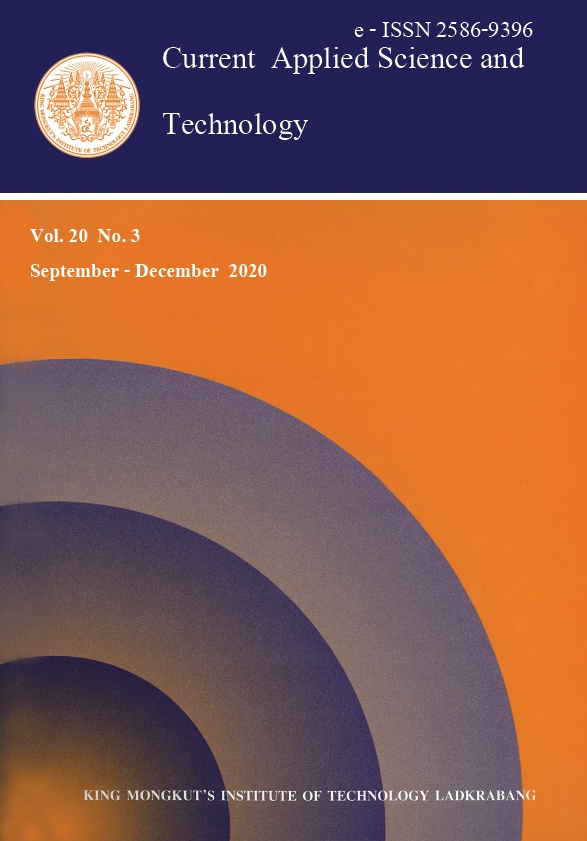A Simple and Green Approach for Colorimetric Ammonia Determination by Combining Pervaporation with Paper Impregnated Anthocyanins Extracted from Red Cabbage
Main Article Content
Abstract
Keywords: ammonia; calcium hydroxide powder; red cabbage anthocyanins; paper-based colorimetric sensor
*Corresponding author: Tel.: +66 87-340-2424
E-mail: wiboon.pra@kmitl.ac.th
Article Details
Copyright Transfer Statement
The copyright of this article is transferred to Current Applied Science and Technology journal with effect if and when the article is accepted for publication. The copyright transfer covers the exclusive right to reproduce and distribute the article, including reprints, translations, photographic reproductions, electronic form (offline, online) or any other reproductions of similar nature.
The author warrants that this contribution is original and that he/she has full power to make this grant. The author signs for and accepts responsibility for releasing this material on behalf of any and all co-authors.
Here is the link for download: Copyright transfer form.pdf
References
Ghaly, A.E. and Ramakrishnan, V.V., 2015. Nitrogen sources and cycling in the ecosystem and its role in air, water and soil pollution: a critical review. Journal of Pollution Effects & Control, 3(2), 136.
Tegeder, M. and Masclaux-Daubresse, C., 2018. Source and sink mechanisms of nitrogen transport and use. New Phytologist, 217, 35-53.
Huff, L., Delos, C., Gallagher, K. and Beaman, J., 2013. Aquatic Life Ambient Water Quality Criteria for Ammonia-Freshwater. Washington DC: U.S. Environmental Protection Agency.
Peters, J.J., Almeida, M.I.G.S., Šraj, L.O.C., McKelvie, I.D. and Kolev, S.D., 2019. Development of a micro-distillation microfluidic paper-based analytical device as a screening tool for total ammonia monitoring in freshwaters. Analytica Chimica Acta, 1079, 120-128.
World Health Organization, 2003. Ammonia in Drinking-Water: Background Document for Development of WHO Guidelines for Drinking-water Quality. Geneva : World Health Organization.
Cheng, Y., Feng, Q., Yin, M., Wang, C. and Zhou, Y., 2016. A fluorescence and colorimetric ammonia sensor based on a Cu(II)-2,7-bis(1-imidazole)fluorene metal-organic gel. Tetrahedron Letters, 57, 3814-3818.
Duan, X., Fang, J. and Sun, R., 2017. Determination of ammonium in aqueous samples by gas phase light scattering using hydrogen chloride gas as a derivatizing reagent followed by nondispersive atomic fluorescence spectrometry. Analytical Sciences, 33, 153-157.
Amirjani, A. and Fatmehsari, D.H., 2018. Colorimetric detection of ammonia using smartphones based on localized surface plasmon resonance of silver nanoparticles. Talanta, 176, 242-246.
Eaton, A.D., Clesceri, L.S., Greenberg, A.E. and Franson, M.A.H., 1998. Standrad Methods for the Examination of Water and Wastewater: 4500-NH3 Nitrogen (Ammonia). 20th ed., Washington DC : American Public Health Association, American Water Works Association, Water Environment Federation.
Krom, M.D., 1980. Spectrometric determination of ammonia: a study of a modified Berthelot reaction using salicylate and dichloroisocyanurate. Analyst, 105, 305-316.
Shoji, T. and Nakamura, E., 2009. Flow injection analysis with spectrophotometry for ammonium ion with 1-naphthol and dichloroisocyanurate. Journal of Flow Injection Analysis, 26(1), 37-41.
Segundo, R.A., Mesquita, R.B.R., Ferreira, M.T.S.O.B., Teixeira, C.F.C.P., Bordalo, A.A. and Rangel, A.O.S.S., 2011. Development of a sequential injection gas diffusion system for the determination of ammonium in transitional and coastal waters. Analytical Methods, 3(9), 2049-2055.
Jayawardane, B.M., McKelvie, I.D. and Kolev, S.D., 2015. Development of a gas-diffusion microfluidic paper-based analytical device (PAD) for determination of ammonia in wastewater samples. Analytical Chemistry, 87, 4621-4626.
Chen, Y., Zilberman, Y., Mostafalu, P. and Sonkusale, S.R., 2015. Paper based platform for colorimetric sensing of dissolved NH3 and CO2. Biosensors and Bioelectronics, 67, 477-484.
Hakovirta, M., Aksoy, B., and Hakovirta, J., 2015. Self-assembled micro-structured sensors for food safety in paper based food packaging. Materials Science and Engineering: C, 53, 331-335.
Maity, A. and Ghosh, B., 2018. Fast response paper based visual color change gas sensor for efficient ammonia detection at room temperature. Scientific Reports, 8, 16851.
Cho, Y.B., Jeong, S.H., Chun, H. and Kim, Y.S., 2018. Selective colorimetric detection of dissolved ammonia in water via modified Berthelot’s reaction on porous paper. Sensors and Actuators B: Chemical, 256, 167-175.
Phansi, P., Sumantakul, S., Wongpakdee, T., Fukana, N., Ratanawimarnwong, N., Sitanurak, J. and Nacapricha, D., 2016. Membraneless gas-separation microfluidic paper-based analytical devices for direct quantitation of volatile and nonvolatile compounds. Analytical Chemistry, 88, 8749-8756.
Almeida, M.I.G.S., Jayawardane, B.M., Kolev, S.D. and McKelvie, I.D., 2018. Developments of microfluidic paper-based analytical devices (PADs) for water analysis: A review. Talanta, 177, 176-190.
Jaikang, P., Paengnakorn, P. and Grudpan, K., 2020. Simple colorimetric ammonium assay employing well microplate with gas pervaporation and diffusion for natural indicator immobilized paper sensor via smartphone detection. Microchemical Journal, 152, 104283.
Zhai, X., Shi, J., Zou, X., Wang, S., Jiang, C., Zhang, J., Huang, X., Zhang, W. and Holmes, M., 2017. Novel colorimetric films based on starch/polyvinyl alcohol incorporated with roselle anthocyanins for fish freshness monitoring. Food Hydrocolloids, 69, 308-317.
Huang, S., Xiong, Y., Zou, Y., Dong, Q., Ding, F., Liu, X. and Li, H., 2019. A novel colorimetric indicator based on agar incorporated with Arnebia euchroma root extracts for monitoring fish freshness. Food Hydrocolloids, 90, 198-205.
Zhang, J., Zou, X., Zhai, X., Huang, X.W., Jiang, C. and Holmes, M., 2019. Preparation of an intelligent pH film based on biodegradable polymers and roselle anthocyanins for monitoring pork freshness. Food Chemistry, 272, 306-312.
Gachovska, T., Cassada, D., Subbiah, J., Hanna, M., Thippareddi, H. and Snow, D., 2010. Enhanced anthocyanin extraction from red cabbage using pulsed electric field processing. Journal of Food Science, 75(6), E323-E329.
Birch, N.C. and Stickle, D.F., 2003. Example of use of a desktop scanner for data acquisition in a colorimetric assay. Clinica Chimica Acta, 333, 95-96.
Oms, M.T., Cerdà, A., Cladera, A., Cerdà, V. and Forteza, R., 1996. Gas diffusion techniques coupled sequential injection analysis for selective determination of ammonium. Analytica Chimica Acta, 318, 251-260.
Poste, A.E., Grung, M. and Wright, R.F., 2014. Amines and amine-related compounds in surface waters: a review of sources, concentrations and aquatic toxicity. Science of the Total Environment, 481, 274-279.


